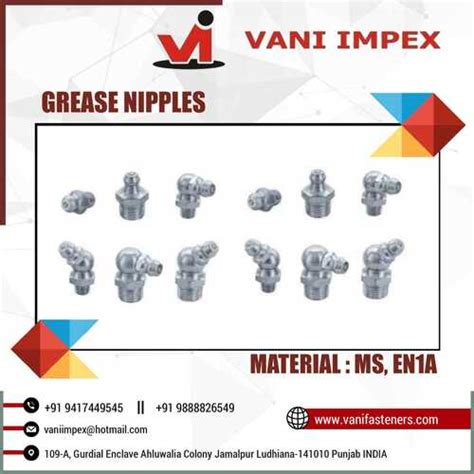Grease Nipples: The Unsung Heroes of Smooth Machinery Operation
Grease nipples, those seemingly insignificant fittings, play a pivotal role in maintaining the health and longevity of your machinery. They serve as the access points for lubrication, preventing friction, wear, and costly breakdowns. In this comprehensive guide, we'll explore the importance of grease nipples, delve into their types, and provide step-by-step instructions on how to use them effectively.
Importance of Grease Nipples
1. Reduced Friction and Wear:
Grease nipples supply lubricant to bearings, gears, and other moving parts, minimizing friction and wear. This reduces the risk of component failure, extending the lifespan of your machinery.
2. Extended Equipment Life:
By preventing friction and wear, grease nipples help increase the lifespan of your equipment. Regular lubrication can double or even triple the life of vital components.
3. Improved Efficiency:
Reduced friction means less energy loss, resulting in improved efficiency. Well-lubricated machinery operates smoothly, consuming less power and reducing operating costs.

4. Reduced Downtime:
Regular lubrication via grease nipples helps prevent unexpected breakdowns, minimizing costly downtime and keeping your operations running.
Types of Grease Nipples
Grease nipples come in various types to accommodate different applications and fitting sizes. Here are the most common types:

| Type |
Description |
Applications |
| Straight |
Simple, non-angled design |
General-purpose lubrication |
| 90-Degree |
Angled design for hard-to-reach areas |
Applications with limited space |
| 45-Degree |
Intermediate angle design |
Versatile applications, offering both clearance and accessibility |
| Hydraulic |
Designed for high-pressure applications |
Heavy-duty equipment, such as construction machinery |
| Button Head |
Flush-mounted design, reducing protrusion |
Applications where space is limited or exposed to impact |
Best Practices for Using Grease Nipples
1. Choose the Right Grease:
Use the lubricant recommended by the equipment manufacturer. Different types of grease have varying properties and are designed for specific applications.
2. Prepare the Grease Gun:
Before connecting the grease gun to the nipple, purge it to remove air bubbles and ensure consistent flow.

3. Connect the Grease Gun:
Ensure the grease gun nozzle is firmly seated on the nipple. Loose connections can allow grease to leak out.
4. Apply the Grease:
Pump the grease gun handle until you observe grease seeping from the joint or bearing. Avoid overlubrication, as it can lead to premature bearing failure.
5. Disconnect the Grease Gun:
Once grease appears, disconnect the grease gun and wipe away any excess.
Common Mistakes to Avoid
1. Neglecting to Lubricate:
Regular lubrication is crucial for extending equipment life. Neglecting this can lead to accelerated wear and costly breakdowns.
2. Overlubrication:
While lubrication is essential, overlubrication can cause damage. Excess grease can attract dirt and form a paste that hinders movement and leads to premature bearing failure.

3. Using the Wrong Grease:
Using the wrong type of grease can result in ineffective lubrication or even damage to the equipment. Always refer to the manufacturer's recommendations.
4. Contaminated Grease:
Dirty or contaminated grease can introduce abrasive particles that damage bearings and other components. Keep grease guns clean and use high-quality grease to prevent contamination.
Step-by-Step Guide to Using Grease Nipples
1. Gather Your Materials:
- Grease gun
- Grease of the appropriate type
- Clean cloth or paper towels
2. Identify Grease Nipples:
Locate the grease nipples on the equipment. These are typically small, hexagonal fittings with a central hole.
3. Clean the Nipple:
Use a clean cloth or paper towel to wipe away any dirt or debris from the grease nipple.
4. Connect the Grease Gun:
Firmly attach the grease gun nozzle to the nipple. Ensure a secure connection to prevent leakage.
5. Purge the Grease Gun:
Pump the grease gun handle a few times to remove air bubbles and establish a consistent flow.
6. Apply the Grease:
Slowly pump the grease gun handle until you observe grease seeping from the joint or bearing. Avoid overlubrication.
7. Disconnect the Grease Gun:
Once grease appears, disconnect the grease gun and wipe away any excess.
Benefits of Using Grease Nipples
1. Reduced Operating Costs:
Regular lubrication can significantly extend equipment life, reducing the need for costly repairs and replacements.
2. Increased Reliability:
Well-maintained equipment is less prone to breakdowns, ensuring uninterrupted operations and increased productivity.
3. Enhanced Safety:
Proper lubrication reduces friction and wear, minimizing the risk of component failure and potential accidents.
Conclusion
Grease nipples are often overlooked, but they play a vital role in maintaining the health and longevity of your machinery. By understanding their importance, choosing the right type, and applying grease properly, you can reap the benefits of reduced downtime, extended equipment life, and improved operating efficiency.
